
Understanding Spondylosis

Spondylosis is also called spinal osteoarthritis. It refers to wear-and-tear degeneration (osteoarthritis) in the joints of the spine, and it becomes more common as you age. Greater than 80% of people older than 40 show some signs of the condition on X-rays, and, according to the Arthritis Foundation, it may affect as much as 75% of everyone over 60.
At Vertrae®, with locations in Dayton and Springfield, Ohio, board-certified neurosurgeon and neurological spine surgeon Dr. Kamal R. Woods and his team see a lot of patients with some form of spondylosis, but they also know not everyone fully understands the term. That’s why they’ve put together this guide — to give you the knowledge you need about this condition and its treatments so you get timely and effective medical care.
All about facet joints
Facet joints are the joints in your spine that let you bend, flex, and move side-to-side, as well as distribute your body weight appropriately. Each of your 24 vertebrae, the bones that make up your spine, are separated by facet joints, one that faces upward and connects with the vertebra above, and the other that faces downward and connects with the vertebra below. They function to keep your spine stable, and because of the way they interlock with each other, they limit how far the spine can bend.
Like the other sections of your vertebrae, the facet joints also protect the spinal cord, which runs through the tunnel created by the space between the facet joints and each vertebral body. And like other joints in your body, the facet joints have shock-absorbing cartilage and are encased with synovial tissue, which produces a lubricating fluid that allows the joints to move smoothly.
How spondylosis begins
Spondylosis begins with inflammation and degeneration of the facet joints and their various components. Osteoarthritis is one potential cause. The cartilage and synovial tissue become worn away from decades of use; you end up with bone grinding on bone, leading to inflammation and pain.
Another potential cause is degenerative disc disease (DDD). As you age, the intervertebral discs begin to dehydrate and thin out. This places more pressure on the facet joints, leading to more friction and more disc degeneration.
The body tries to stabilize the joints by creating bone spurs and/or by causing the joints to swell, both of which restrict their movement and cause further pain. Without movement, the synovium doesn’t produce the lubricating fluid needed for the joints to move, and so they may start to stiffen, becoming more difficult and painful to move.
Spinal stenosis is a third cause. It occurs when the spinal column within your vertebrae narrows, placing pressure on (“pinching”) the spinal cord nerves. The narrowing happens gradually and can appear anywhere along your back. The narrowing can be due to anything that causes joint degradation.
Spondylosis symptoms
Spondylosis can affect the joints in any part of the spine, but it occurs more commonly in the neck (cervical spine) and lower back (lumbar spine). The lower back works to distribute most of the body’s weight, causing stress. Over 80% of US adults older than 40 may have lumbar spondylosis, though most are asymptomatic.
When spinal spondylosis does cause pain, it can affect your range of motion. If the spondylosis advances to the point where it compresses the nerves in the neck or lower back, it can result in pain, numbness, and/or weakness in the arms and legs.
Other common symptoms include:
- Stiffness: especially after inactivity or rest
- Paresthesias, or abnormal sensations, include numbness and tingling
- Limited range of motion
- Difficulty standing straight, or improper spinal alignment
Spondylosis treatments
Dr. Woods always starts with the most conservative treatments, only progressing to surgery if the treatments aren’t helpful.
Some nonsurgical treatments are:
- OTC pain medications, anti-inflammatory drugs, and muscle relaxants
- Injection therapy: includes nerve blocks, steroid injections, and trigger point injections
- Radiofrequency ablation of the nerves in the facet joints can provide pain relief for 3-6 months
- Physical therapy: includes ice, heat, massage, ultrasound, and targeted exercises
Spondylosis surgery has two main components: removing what’s causing pain and fusing the spine to control movement — decompression and stabilization. The goal is always to relieve pressure from the spinal cord or other nerves. Some common surgical interventions include:
- Decompression procedures: remove bone spurs (foraminotomy), herniated discs (discectomy), or part of the vertebra (facetectomy).
- Stabilization surgery: spinal fusion stabilizes vertebral segments using bone graft and hardware.
- Disc replacement
A decompression and fusion may be done simultaneously.
If you're feeling pain and stiffness in any part of your back, it's time to come into Vertrae and let Dr. Woods evaluate you for spondylosis. Give the office a call at either location, or book your appointment online.
You Might Also Enjoy...


4 Benefits of Outpatient Spine Surgery

Am I a Candidate for Kyphoplasty?

Pulled Muscle vs. Pinched Nerve: What's the Difference?

4 Subtle Signs of Sciatica

